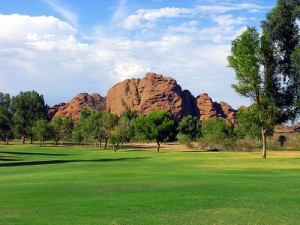Papago Golf Course: A Championship Test
By Marina Beach • Mar 8th, 2012 Tucked amongst the Papago Buttes, Camelback and South Mountains, nestles a great Phoenix city-owned regulation golf course: Papago. The locally known gem is only 15 minutes out from Sky Harbor Airport, which makes it a must-play even while vacationing.
Tucked amongst the Papago Buttes, Camelback and South Mountains, nestles a great Phoenix city-owned regulation golf course: Papago. The locally known gem is only 15 minutes out from Sky Harbor Airport, which makes it a must-play even while vacationing.
Although Papago adds to the list of desert-like courses here in the Valley, a golfer can certainly experience a round without it feeling like a typical desert course. Papago consists of settle rolling terrains, voluminous trees, and luscious Bermuda fairways, impersonating a different setting. The massive greens are smooth and consistent, which roll between a 10 and 11 on the stimpmeter during the peak season.
In 2008, Papago went through an extensive restoration to prepare for the 2009 Phoenix LPGA International. Billy Fuller, course architect and former superintendent at Augusta National, kept much of the original design, only making a few improvements to turn it into the championship-style course it is today.
The process was not simple, but under Fuller’s design team, the project was completed in just eight months. Some of the major changes included: Complete green and fairway pulverization, several tree removals, a driving range expansion, and regrassing the entire golf course and practice facility.
Papago now provides a much more challenging and lengthy layout for the serious golfers, but also remains playable for more relaxed golfers. The remodeled course plays 7,333 yards from the tips and includes three par 3’s distancing over 230 yards. Strategically cavernous bunkers are placed throughout the entire course, which demand tee and approach shot accuracy. Without precision, a golfer can expect a sandy day at the beach.
Papago has numerous false fronts and elevated greens, which also adds difficulty to reaching greens in regulation. Commonly large greens help compensate the difficulty of approach shots, but can also add yet another challenge—long putts. A lot of the greens appear to be flat, but they actually tend to break more than expected (many putts flow toward Downtown Phoenix).
Now for a list of the more notable holes:
Hole number one gets things off to a nice start. The open 561-yard par 5 is mostly forgiving if a player favors the left side of the fairway. Large trees block the dogleg right fairway and water lies toward the upper right fairway and green, which definitely comes into play with an errant right shot. The elevated, deep green slopes toward the water, so don’t be surprised to a see a pin placement favoring that right side.
Hole number three is the longest par 4 out on the course distancing 467 yards. Although it is lengthy, it is not too difficult. The fairway is wide open, but deep bunkers surround the green. If you avoid the bunkers, the hole can be a par.
The last hole on the front is considered to be the most difficult hole on the course. The par 5, 542-yard hole, presents fairway bunkers, water on the right, and two greenside bunkers—one on the left and one on the right. This hole demands extreme accuracy.
Personally I think hole number 17 is the most difficult par 3 on the course. Although the scorecard says 243 from the tips, it definitely plays long, so club up. Four large, deep bunkers frame the green—one in the front and three along the left and back.
 Finally, hole number 18 is worth taking note of. It is a gorgeous finale with numerous trees coming into play along the right side of the fairway. The uphill par 4, 464-yard hole is long and tough to cut distance from. An accurate tee shot is needed in order to avoid out of bounds on the left and towering trees on the right. If you are not a long hitter, this hole is challenging to get on in regulation.
Finally, hole number 18 is worth taking note of. It is a gorgeous finale with numerous trees coming into play along the right side of the fairway. The uphill par 4, 464-yard hole is long and tough to cut distance from. An accurate tee shot is needed in order to avoid out of bounds on the left and towering trees on the right. If you are not a long hitter, this hole is challenging to get on in regulation.
Overall Papago is an above average public course. The staff is very courteous and welcoming. Player assistance on the course was also fantastic and the rangers encourage a good pace of play.
William Bell designed Papago with the player in mind. With the Arizona heat, it is most important to stay hydrated, and Papago does just that with several opportunities to fill up. The halfway house is centrally located, allowing multiple opportunities to stop.
Before beginning the round, enjoy a nice warm-up on the practice facility. The driving range is in excellent condition and provides enough length even for the longest drivers. The putting green rolls very smoothly and matches the course conditions.
Papago hopes to extend their facility in the near future by incorporating a teaching center and a top-notch clubhouse. The teaching facility will focus on all aspects of the game and allow all skill levels to “become as good as they can be,” according to their website. The clubhouse will feature a full-service golf shop, a restaurant, a pavilion for hosting large events, and multiple conference rooms for smaller group events.
Current weekday fees range from $37-$52 walking and $49-$64 riding, and weekend rates range from $47-$62 walking and $59-$74 riding.
This historic 1963 course sees more than a 100,000 rounds a year and is definitely one worth playing.



